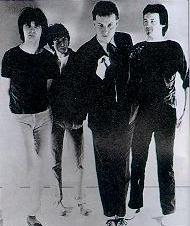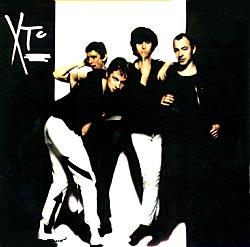Dramatis personae
The personnel haven’t so much changed over the years, as whittled down
to the core song writing partnership of acknowledged leader, guitarist Andy
Partridge and his bass-playing sidekick Colin Moulding.
Partridge is, even by his own admission, a little
strange. A valium-addicted child, prone to self-doubt and depression, he knew
early on that music was his outlet and stuck to that through thick and thin. He
has: a passion for comics, books and toys; an inquisitive interest in
industrial and English history, especially architectural; a love of theatre,
music hall, circus and all the good old traditional English entertainment; a
love-hate relationship with the mechanics of power and the establishment; an
objective interest in faiths, creeds and religions; and a celebratory and
unembarrassed attitude towards sex and the resultant love of women, children
and life itself. He’s a walking contradiction – he abhors violence of any sort,
yet collects tin soldiers obsessively. A retiring fellow (and self-confessed
awkward bugger) in normal life, he becomes a control-freak in the studio.
Moulding is slightly different. He displays the
comfortable acceptance of the joys of maturing in little England which comes
from the grounding effect of starting a family early. He has an eye for the
minutiae of English life akin to the films of Mike Leigh and Ken Loach. Colin
came from a long line of musicians and has always been less of the tortured artist
and more of the contented musician. However, his views of the world – pragmatic
and often simplistic – are the perfect foil for the Partridge whimsy. He’s also
one of the best bass players you’re likely to hear in the pop universe – and
it’s this, plus his exquisite vocal harmonies which make him the indispensable
“other half” of XTC.
|
For the first few albums they were ably assisted by keyboardist Barry
Andrews, known as “the mad monk of punk” and drummer Terry Chambers, a
hard-drinking man’s man – and stereotypical drummer – if ever there was one.
But XTC soon let slip their tenuous ties to punk, and with them Andrews and,
eventually, Chambers. For many years, in came Dave Gregory, the diabetic demon
of the six string plank – a man who could play every lick by every band they
loved and could write out the dots as well!
|

XTC (from left): Colin Moulding, Terry Chambers, Andy Partridge and Dave
Gregory |
The early years were a nightmare whirl of
recording-touring-recording-touring which left them knackered, skint and close
to breaking point. It was only when Partridge succumbed to his hatred of
playing live and quit touring (thereby turning XTC into a studio band and, with
it, giving rise to the greatest dichotomy of all – the vast majority of XTC’s
fans have never seen them play live) that they began to flourish in the many
different directions that has kept them interesting, vibrant and at the
forefront of great British songwriters – a group that includes The Beatles, The
Kinks and Squeeze. Although their reference points are as likely to feature
Stanshall, Beefheart and Coward. The band, who as Helium Kidz were the stars of the
young ‘Swindon circuit’ in the late 70’s, was signed by Virgin in a bidding war
in 1977. Originally, they were highly prolific, raiding the extensive Partridge
and Moulding back-catalogues, resulting in 1978’s debut “White Music”, swiftly
followed by the second studio release “Go 2” in the same year and “Drums and
Wires” a year later.
So this is how a recording studio works . . .
Barely a week after signing with Virgin, XTC were in
Abbey Road to record their first studio album. For avowed Beatles fans, it was
hallowed ground and producer John Leckie made the most of their enthusiasm and
wonderment. The band look back in amazement at how a whole album was made in
four weeks – including five promo videos shot in one day!
 |
White Music
(left) sounds exactly like a debut album should. It overflows with youthful
exuberance, and the sound of a band discovering recording studios for the first
time. From the classy new-wave melodicism through to the quirky spazz-out
keyboards, White Music is the sound of genius learning to walk.
Standout tracks from White Music include, Radios In Motion, This Is Pop! and
Statue of Liberty. The first, a shotgun list of buzzwords, was the
traditional live set opener in the early days, while the second was the first
of many of Andy’s attacks on the music industry, with him railing against the
tendency to compartmentalise different styles of music. In his mind, ice cream
was ice cream – maybe different flavours, but still ice cream, so why couldn’t
the different flavours of popular music still be ‘pop’ without suddenly
becoming tragically unhip?
|
Statue of Liberty was inspired by a girlfriend doing
the ironing! In Andy’s words, “she was standing there in her nightie, holding
the iron up, trying to get it untangled. I said ‘you look like the Statue of
Liberty’ and thought ‘Oh Yeah, that’s got to be a lyric I can use’.”
The second album, the first defection
White Music barely scraped the Top 40 album chart,
but XTC then came up to London to record Go 2. Sharing a flat in Belsize
Park full of dirty dishes, even dirtier clothes and “a carpet somewhere under
the empty food cartons” was hardly rock’n’roll. But hey, they were on the
ladder – on £25 each per week!
But take four young men, stuff them into a small
basement flat, tell them they’re rock stars and you’d better stand well back.
Not only were the recording sessions unhygienic, they were turbulent as
tensions were beginning to show. It was during the recording of Go 2 that
things fell apart between Andy Partridge and Barry Andrews.
Although Andy was the obvious leader of the band,
Barry’s on-stage madness – and his obvious love of being the ‘rock star’ –
endeared him to the fans. However, it was his insistence on being “in on the
song writing bit” that led to the split. While Andy tolerated Barry’s two
contributions to the second album, they patently weren’t up to the required
standard – and there was simply not enough room for two egos the size of Andy’s
and Barry’s.
In the end, they couldn’t be in the studio together
and would record their parts on different days. It was never going to work. The
catalyst came when Barry found out that Andy had being ‘courting’ local
six-string hero Dave Gregory to contribute. At the end of the recording of Go
2, Barry threw in the towel with a resigned “see ya chaps.” It’s comforting to
note that, not only did Barry subsequently find fame with his own band
Shriekback, but relationships between Andy, Colin & Barry were repaired
many years ago and it’s pleasing to the soul to note that Barry and Andy are
now old mates.
Anyway, that was that! It was Andy’s band. Barry was
gone. Dave was in – replacing a keyboard player with a second guitarist –
risky? Certainly many fans thought so and it took a few blistering gigs before
he was accepted
Overall, Go 2 is perhaps not as stunning as its predecessor. Many put
this down to the inclusion of the two Andrews-penned songs. Barry certainly
knew how to get some f****d-up noises out of his keyboard, but back in 1978 he
should have been locked in a cupboard until he promised to stop writing songs.
 |
Who is this Dave Gregory bloke, anyway?
Dave Gregory is about the least likely ‘Rock God’ you
could ever imagine. Terminally shy, with a soft lilting voice, and a slight
squint – not to mention his diabetes, which required his ‘emergency bag’ of
Mars Bars – he was known to those who worked with him as “Squinty Two Strats”,
which also gave away his preferred choice of guitar!
But Oh Lordy, the man can play. Andy – a self-taught,
instinctively brilliant player – was, and continues to be, in awe of Dave’s
ability to stand at the back of the stage/studio, layering gorgeous sounds over
the songs. Oh, and he could also play a mean keyboard – which helped!
It should be noted that Dave’s XTC career nearly
finished before it started. At their first rehearsal together, things went
poorly. In Dave’s words: “I drove through two feet of snow to get there and I
remember Andy stopping the proceedings halfway through the first song and
telling me to stop ‘Ernying’. I said ‘you what?’ And he said ‘stop going
erny, erny, erny!’ It was just one of my clichéd licks.”
For the next year, XTC was a touring machine – a fan
once calculated that, in the 252 days between leaving the studio after Go 2 and
entering for Drums & Wires, XTC played a gig on 202 of them – something the
band reckon is pretty close to accurate.
They were travelling the world . . . to a fashion.
Sleeping in a camper van, driving for hours to make the next gig, still earning
£25 a week, writing songs on napkins, motel notepads and toilet paper and
surviving on beer and free bar snacks.
Phew, rock’n’roll . . !
Part 2
|


